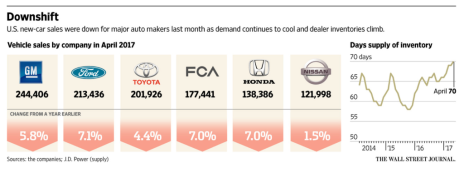Experts have been predicting the demise of the U.S. auto industry for the past year. Until recently, however, signs of a let-down have been missing—demand for sedans had clearly weakened, but sales of SUVs, crossovers and pickup trucks had been very strong.
The U.S. auto industry has been on a joy ride during the seven years since the 40% drop in new car sales in 2008-2009. But demand cooled in the first four months of 2017 despite substantial discounts and financing incentives. According to J.D. Power, discounts are nearing an average of $4,000 per car or truck sold.
Demand in April turned surprisingly sluggish for the trucks and SUVs that fueled the record sales and profits for U.S. auto manufacturers. Overall, auto makers sold 1.43 million vehicles in the U.S. in April, down 4.7% from a year earlier, according to Autodata Corp. The following graphic, reprinted from The Wall Street Journal, illustrates the severity of the April decline in the auto industry.
[text_ad use_post='129631']
Auto industry optimists point out that the average age of vehicles in the U.S. is near record highs, and the need to replace old vehicles will prevent the current downturn in auto sales from falling further. The average age of light vehicles in operation in the U.S. is currently 11.6 years, according to industry experts at IHS Markit, a leading provider of business information and analysis for the global automotive industry.
Better-quality vehicles, though, will likely keep older vehicles on the road longer. Bad news for car makers, but companies and shops that provide vehicle maintenance and auto parts should benefit. (Read on for my recommendation of an automotive stock that will benefit from this trend.)
Bears also point out that new and used car inventories are at record highs. Dealers take far longer to sell off inventory, resulting in a glut of unsold cars and trucks. General Motors (GM), the No. 1 U.S. auto maker, has nearly one million vehicles sitting on dealer lots.
Cutting inventory levels will not be easy. Car leasing has become popular with dealers and buyers, but two- and three-year car leases are coming due. When leases expire, cars are returned to the dealer, and the dealer’s used car inventory expands.
After years of revving up auto loans, the banking industry is pulling back sharply from auto loans, helping to drive a decline in car sales and raising fears the slump might deepen. Wells Fargo (WFC), one of the largest U.S. auto lenders, last month reported a 29% drop in its auto loan originations for the first quarter from a year earlier. The decline is similar to quarterly reports from lenders J.P. Morgan Chase (JPM) and Ally Financial (ALLY) as well.
Lenders are now recording higher losses on defaulted auto loans, caused by a mix of more borrowers falling behind on payments and the declining value of used cars. Lenders are now recovering less than 50% of the unpaid loan balances on repossessed cars, according to S&P Global Ratings.
What’s Next for the Auto Industry?
Normally, auto sales pick up considerably during the summer. Auto makers and dealers are convinced that this summer will be no different, even after poor sales during the first four months. And with oil prices dropping, gasoline prices should drift lower during the next several months. Lower gas prices will translate into more summer driving, which could bolster car sales during the next three to six months.
GM will close some factories later this year to prepare its assembly lines for new models. Executives say a lack of new supply in the second half will help reduce swollen inventories. Job growth prospects and wage increases for buyers, and lower gasoline prices will also help boost sales. GM, which has 17% market share, is carrying more than 20% of the industry’s inventory.
GM is already experiencing relatively low utilization of its North American factories, according to WardsAuto.com. The company has laid off thousands of hourly employees due to a collapse in demand for passenger cars. Now, its core truck business is also showing fatigue.
One Automotive Stock to Buck the Decline
With car and pickup truck sales expected to fall further, the age of existing vehicles on the road will lengthen. Older vehicles will require more maintenance and repairs. LKQ is a leading supplier of auto parts for used cars and will benefit from the current trend in the auto industry.
LKQ Corp. (LKQ) is one of the largest providers of recycled automotive replacement parts with 100 sales and processing centers in North America and Europe. LKQ buys wrecked cars at auctions, salvages the reusable parts, and sells the parts to collision repair shops. The company primarily serves collision and mechanical repair shops, new and used car dealerships, metal recyclers and retail customers. LKQ was founded in 1998 and is headquartered in Chicago, Illinois.
LKQ has established an enviable record of steady 20% sales and earnings growth during the past decade through its aggressive acquisition program. The company’s recent purchases in the U.K., Ireland and The Netherlands are typical acquisitions that will help diversify LKQ’s operations and add profits in 2017 and beyond.
Acquisitions have played an important part in LKQ’s success, but LKQ’s existing operations have added significant growth, too. LKQ’s vast distribution network provides the company with key competitive advantages, including faster delivery and more in-stock parts than its competitors. The industry’s shift to replace automotive parts with used components versus new components will continue.
Sales in the first quarter surged 22% and EPS (earnings per share) advanced 17% after sales increased 24% and EPS climbed 27% in 2016. Management raised its 2017 EPS estimate slightly. Acquisitions and much improved sales in Europe bolstered results while sales in the U.S. slumped a bit. Sales and EPS are predicted to climb 15% in 2017, but new acquisitions could drive sales and earnings higher than my forecast. Also, LKQ pays a high 35% tax rate, so any reduction in the tax rates for corporations will benefit LKQ.
At 18.0 times current EPS, LKQ still qualifies as a value stock, the balance sheet is very strong, and growth is steady and rapid. The company does not pay a dividend. I expect LKQ’s stock price to advance 36% to my Minimum Sell Price of 42.71 within 12 to 18 months. Buy LKQ.
Until next time, be kind and friendly to everyone you meet.
[author_ad]

